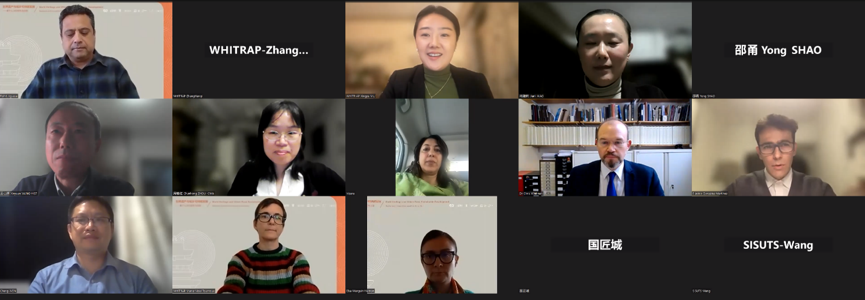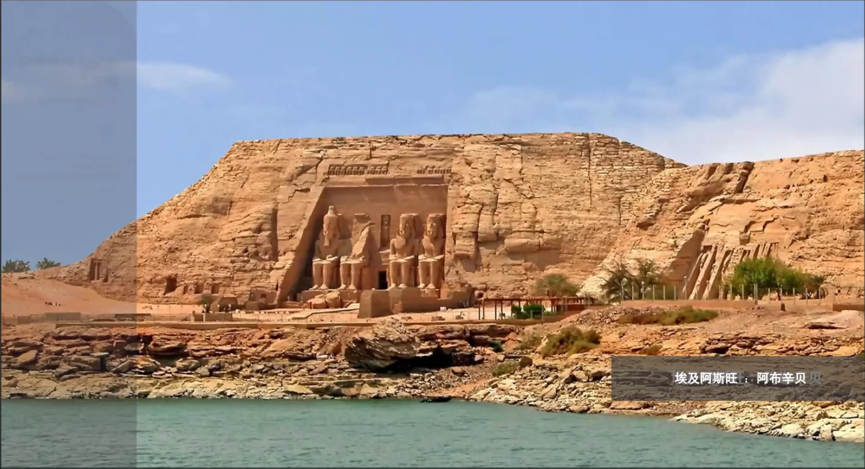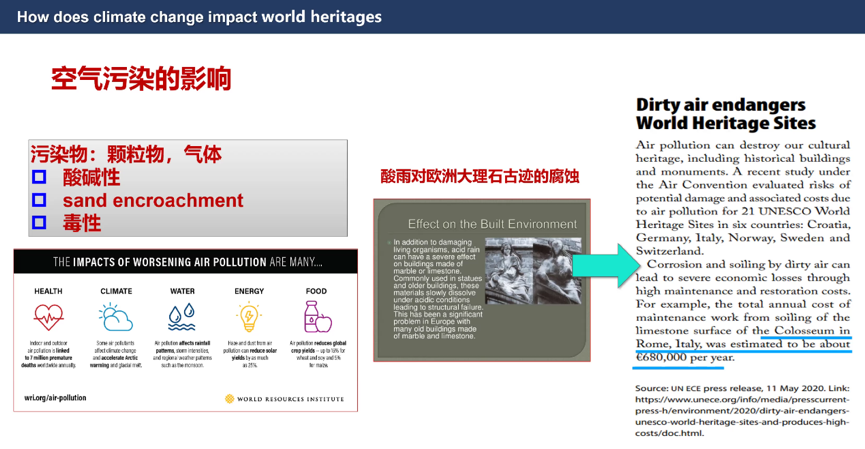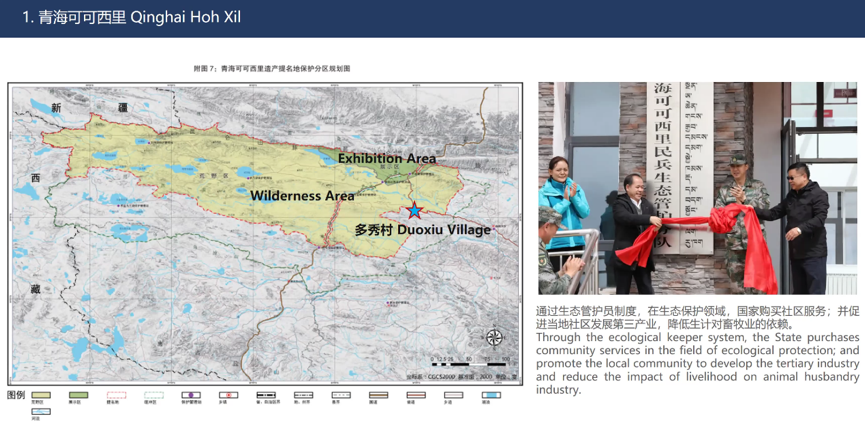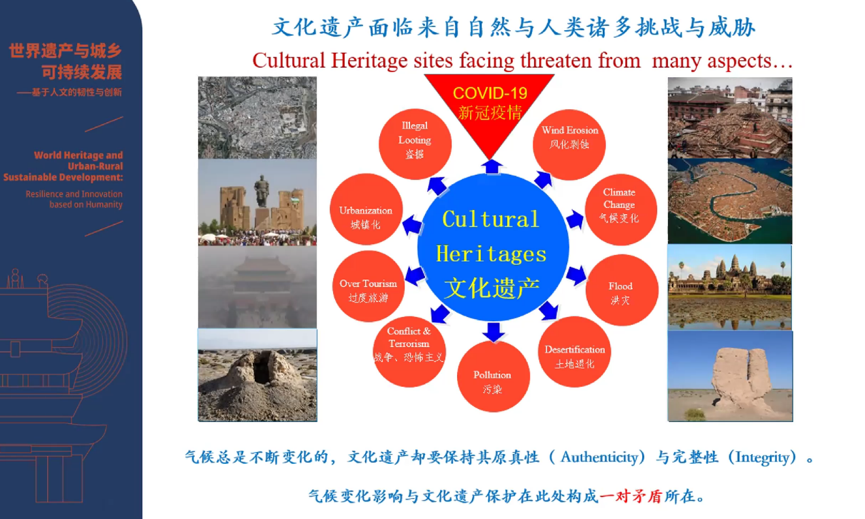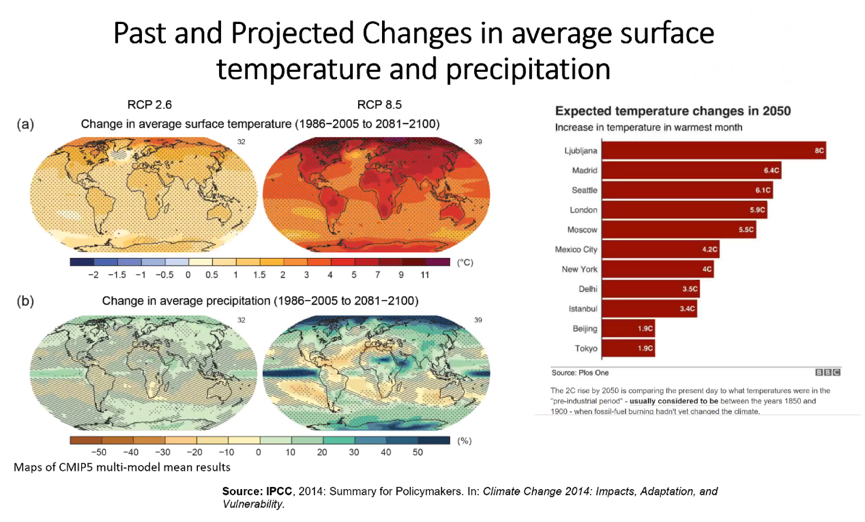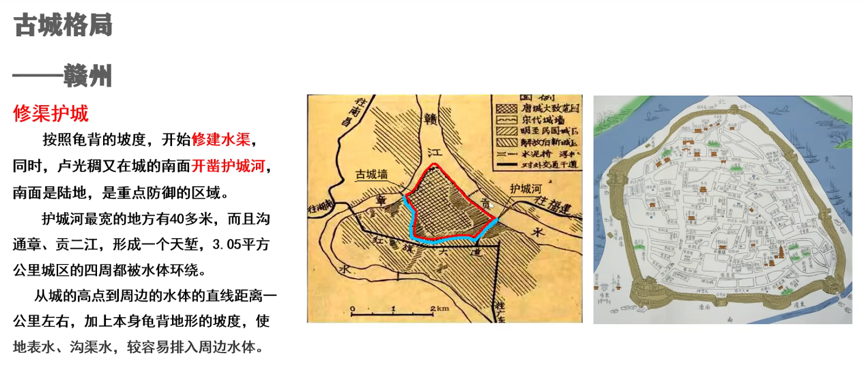| Highlights of Topic 3 at the Conference |
| PublishDate:2022-12-15 Hits:734 |
Since 2005, with the frequent occurrence of global warming and various meteorological disasters, climate change has gradually become one of the important issues in world heritage conservation and urban-rural heritage resilience. How to deal with climate change will have a profound impact on the sustainable development of human civilization and life. On the occasion of commemorating the 50th anniversary of the World Heritage Convention, the 40th anniversary of China’s National Famous Historical and Cultural Cities Protection System, as the 70th anniversary of the founding of the College of Architecture and Urban Planning of Tongji University and the series of academic activities of "Tongji Planning Centennial", the third thematic sub-forum of the conference focused on the "World Heritage and Urban-Rural Sustainable Development: Resilience and Innovation based on Humanity". The participants approached climate change and urban-rural heritage resilience from the topics of climate change and World Heritage, natural heritage, cultural heritage, urban response to climate change and historical urban resilience.
The session was co-chaired by Dr. Mu Xingyu, a Project Director of WHITRAP Shanghai, and Rohit Jigyasu, a project manager of the Urban Heritage, Climate Change and Disaster Risk Management at ICCROM. The session invited Professor Zhou Chunhong, a researcher of the Chinese Academy of Meteorological Sciences, Jim Perry, a HT Morse Distinguished Professor at the University of Minnesota, Dr. Wen Cheng, an expert of the Species Survival Commission (SSC) of IUCN, Wang Xinyuan, the Deputy Director of the UNESCO International Centre on Space Technologies for Natural and Cultural Heritage under the Auspices of UNESO (HIST), and Xiao Jianli, an Associate Professor of the College of Architecture and Urban Planning of Tongji University, to deliver keynote speeches. Prof. Plácido González, a professor of College of Architecture and Urban Planning of Tongji University and the Executive Editor of Journal Built Heritage, and Prof. Chris Whitman, a senior lecturer and course leader of Cardiff University and a guest editor of Built Heritage on the topic of "Climate Change", participated as guests of panel discussion. Group photo
Part.1 Theme Introduction
Dr. Mu Xingyu gave an overall introduction to the session. From the perspective of sustainable development of human society and heritage conservation, she reviewed the history and the birth of the World Heritage Convention for the Protection of Cultural and Natural Heritage, and introduced the story that the United Nations organization gathered hundreds of experts and collaborated with various countries to help the Egyptian government relocate the two temple monuments of Aswan and Abu Simbel, while securing the construction and operation of the Aswan High Dam. She mentioned Piero Gazzola, the founder of ICOMOS, Liang Sicheng, ta pioneer of Chinese traditional architecture conservation, and Ruan Yisan of Tongji University, emphasizing the need to give consideration to the protection of cultural heritage values in the face of any difficulties. She also recalled another important reason for the birth of the Convention - the heavy rains that plunged the ancient cities of Venice and Florence into floods in 1966, causing great damage to precious cultural heritage, and thus the issue of climatic disasters was considered from the very beginning of the Convention. She believes that the remarkable achievements of the Convention in its fifty years are inseparable from the efforts of the States Parties and the region. The other three anniversaries of this conference reflect exactly the evolution of historical city conservation in China. During these decades, the scale and dimensions of heritage sites are changing. We are not only focusing on heritage per se, but also starting to look at various factors such as the tangible and intangible, monitoring, and management. Dr. Mu believes that the climate change involves the global scale, and also works as a complex system rather than a single entity, thus the climate change and urban-rural heritage is a series of issues arising from the two complex systems. What is more noteworthy is that, unlike 50 years ago, we are now faced with new and more complex and imminent issues. She pointed out that in November UNESCO warned that many iconic world heritage sites glaciers will disappear by 2050. The two temples of Aswan and Abu Simbel © Mu Xingyu
Part.2 Keynote Presentations
Prof. Zhou Chunhong introduced her research in meteorology and her interest in humanities. She talked about what climate change is and how it relates to heritage conservation from a meteorological perspective. The Earth's atmosphere can maintain the energy balance, and greenhouse gases disrupt the energy balance of the Earth's atmosphere due to the increase of human activities. Greenhouse gases include CO2, methane, N2O, etc. CO2 has increased almost 1 time from 1985 to the present compared to the pre-industrial revolution. The average temperature of the Earth's surface has increased by nearly 1°C since 1850-1900 and is expected to increase by 1.5°C in the next 20years. If the average temperature of the Earth's surface increases by more than2°C, it will cause irreversible damage to the Earth's environment, so many countries around the world are beginning to control carbon emissions. The effects of climate change include issues such as sea level rise, precipitation anomalies, and other extreme weathers. She introduced the impact of climate change on heritage with a few cases, and the impact of air pollution on climate. She proposed that heritage should be integrated with economics, ecology and meteorology (climate change, air pollution) to provide inspection, monitoring, assessment, early warning and conservation measures. The Impact of Air Pollution on World Heritage © Zhou Chunhong
Prof. Jim Perry started the discussion on the management of heritage sites by asking questions to inspire the audience to think about the changes in heritage sites under the impact of climate change, and further proposed "adaptive heritage" and outlined the 6 principles of this system. He also emphasized the "dynamism" and "living heritage", the importance of considering heritage in a landscape context, and put forward the idea of being bold enough to act.
Mr. Wen Cheng introduced the spatial relationship between China's climate change exposure and China's World Natural/Mixed Heritage Sites and Natural Heritage Potential Areas, by giving two World Heritage Sites located in areas of high climate change exposure – Hoh Xilin Qinghai and Sanjiang River in Yunnan. He also resented the recent adaptive management models and practices. Finally, he summarized the experiences and ideas gained based on the two case studies.
Most of the existing World Natural Heritage sites and World Mixed Cultural and Natural Heritage sites in China are located in areas with high exposure to climate change, and their conservation management is facing the issue of adaptation to climate change. The Hoh Xil Heritage Site in Qinghai and the Three Parallel Rivers of Yunnan Protected Areas are both significantly impacted by climate change. In recent years, climate change has mainly manifested itself in the form of increased temperature and humidity in Hoh Xil, with both positive and negative impacts. Positive impacts include an increase in basal biomass and an increase in the number of herbivore-based animals. On the negative side, the alpine grassland, alpine meadow and alpine desert have become swamps, and the area of quality habitat for large hoofed animals has decreased. The water level of rivers and lakes has increased, and the original migration paths of animals have been interrupted. In addition, the increase in livestock and pastoralists around heritage sites due to climate warming poses a potential threat to local ecosystems. China has constructed national parks in recent years to protect the wilderness state of the uninhabited areas of Hoh Xil. The government has guided local villagers to benefit from the conservation and management of the heritage site by setting up public service positions for ecological caretakers and guiding herders into tertiary industries, reducing pressure on natural resources. The growth in the range and numbers of wild yaks is evidence of the positive effects of heritage conservation. The shrinking of alpine glaciers and the increase of extreme events of drought and flood in the Three Parallel Rivers region of Yunnan. Since 2012, local Chinese NGOs have been empowering local communities with technical trainings and organizational capacity buildings to promote multi-stakeholder participation in conservation initiatives. Local beekeeping has been used to reduce the pressure on the ecosystem from livestock farming. Survey data show that the population of the site's flagship species, the Yunnan golden monkey, has grown from about 1,500at the time of the inscription to nearly 4,000.
The impact of climate change on natural World Heritage sites can be positive or negative. The observations of the above two cases show that it is possible to mitigate the negative impacts of climate change and induce its positive transformation as long as we take active and wise management measures.
Ecological Management of Hoh Xil © Wen Cheng
Mr. Wang Xinyuan provided his thoughts on climate change and the resilience of historical and cultural heritage from the perspective of spatial information technology. The report was divided into three parts: the first part used three cases to introduce the function of cultural heritage as a "recorder" of climate change, taking the Chaohu Lake basin as a case study, correlating the distribution of sites and cultural development in the Chaohu Lake region with climate change and the water level of Chaohu Lake in different periods, and introducing the spatial and temporal distribution characteristics of cultural remains driven by climate and tectonics. The second case was the Great Wall from the Han Dynasty-Ming Dynasty, where the latitudinal position of the Great Wall in northeastern China changed across 10°, reflecting the significance of the historical record of the changing location of the Great Wall under the combined influence of climate change as well as national politics and military situations; the third case was the past ecological changes reflected by the ancient Roman border walls and their defense and supply systems (castles, border walls, roads, irrigation systems, towns, etc.). The second part was about the perception of the resilience of cultural heritage in ancient cities under climate change. It introduced the different resilience of cultural heritage under different climatic conditions, including the sometimes-dramatic impact of slow and long-term environmental changes on cultural heritage, the catastrophic impact of disasters caused by extreme weather on cultural heritage, and the frequent disturbance of cultural heritage due to the expansion of human activities driven by climate change. The third part conducted a reflection on cultural heritage resilience and building resilient cities. Using the Tarim Basin and Chengdu Plain as case studies, the resilience of cultural heritage was introduced. We are urged to learn resilience from cultural heritage and build resilient cities today, so three recommendations were made: 1. making full use of spatial information technology monitoring and prediction analysis capabilities to enhance the ontological resilience of cultural heritage; 2.linking past research on global change and community sustainable development to enhance the resilience of cultural heritage endowment environments; 3.establishing a cultural heritage conservation discipline to proactively and effectively responding to the risk impacts of natural change and human activities. Challenges and threats to cultural heritage © Wang Xinyuan
Rohit Jigyasu presented how to build resilience of urban heritage against disasters and climate change.
First, he presented examples of disasters such as past changes in temperature and precipitation, simulation of greenhouse gas emission scenarios and associated risks, and the frequency of various types of disasters during 1990-2016, such as floods in Pakistan, Germany and Belgium, Balkans, and Eastern Europe, etc., and cases of stone cities in Zanzibar experiencing sea level rise, floods and fires, thus suggesting the issue of potential factors influencing the vulnerability of heritage disasters and climate change. Secondly, the increase of the world urban and rural population, urban residents lead to the rational vulnerability of cultural heritage. He recounted the example of the World Heritage Ahmedabad Historic District, the abandoned heritage of small and medium-sized towns, residents leaving the buildings, the lack of landscape and arable land led to sustainability issues. From 1782-2013 the frequency of floods increased, especially in the last years, and the cities were increasingly affected by floods. Even for cities with similar populations, not all cities are similarly affected, and physical impacts can be influenced by multiple aspects such as environment, social change, population security, heritage deficit, and economic deficit, requiring a combination of different dimensions of urban systems, vulnerability, and climate change systems to consider the problem.
These cases demonstrated how urban heritage can improve energy efficiency through control of microenvironment, ecological footprint and socio-economic sustainability and the need to integrate traditional and contemporary knowledge on disaster mitigation and climate change adaptation. He pointed out that there are numerous examples of how to effectively manage heritage sites to overcome boundary constraints, and that climate change is also causing people to shift their lifestyles to overcome some natural hazards. Climate change cannot be compartmentalized and requires a combination of sustainable development, climate change adaptation, disaster risk reduction and heritage conservation and management to overcome major challenges. He also emphasized the importance of combining top-down and bottom-up approaches to meet disaster risk reduction and climate change adaptation objectives.
Surface temperature and precipitation variation © Rohit Jigyasu
Professor Xiao Jianli introduced the concept of disaster resilience, including the significance of disaster resilience, disturbance and equilibrium state. She proposed that urban resilience includes four attributes: robustness, redundancy, rapidity and resource deploy ability. The disaster resilience of ancient cities in China is mainly reflected in four aspects: pattern, facilities, streets and buildings. She gave two examples, including Ganzhou and Guangfu, to introduce the resilience of the ancient city pattern in terms of site selection, wall expansion, canal construction, and layout. In terms of ancient city facilities, she introduced Ganzhou's very distinctive Fushou Ditch system, the core of which is to build ditches and windows to drain and prevent flooding. She introduced in detail the composition, principle and structure of the Fushou Ditch and its value features: 1. the mastery of nature; 2. the ingenious design; 3. the artisanal construction and the use of local materials. She also introduced the example of the Moon Dam in Shou County, showing several major functions of the Moon Dam in terms of water drainage and flood control. In terms of ancient city streets, she introduced the flood control design of Tongguan Shuipo Lane and the fireproofing facilities of the square walls of Linhai Ziyang Street. In terms of architecture, she introduced the fire prevention function of the square wall of Nanxun Hundred Rooms Building, and the earthquake prevention mechanism of Wenchuan's wooden structure traditional buildings. Through the above case studies of disaster resilience of ancient cities and towns, Professor Xiao summarized the traditional wisdom of Chinese urbanism: the ecological view of unity of heaven and man, the development view of mutual benefits, and the creation view of comprehensive balance.
The Pattern of the Ancient City of Ganzhou© Xiao Jianli
Part.3 Discussion
The discussion session was moderated by Mr. Rohit Jigyasu, and different questions were asked to the two guests who participated exclusively in the discussion.
Regarding to the question “how to prioritize matters to address climate change impacts?”, professor Plácido González pointed out the potential of response methods and the limitations of measures to address climate change. He offered to learn from some of the conventional wisdom about how to adapt. Care needs to be taken to avoid becoming too idealistic arising from nostalgia as a key point of discussion on economic and political issues.
"What do you think organizations such as WHITRAP and ICCROM should do to combat climate change?" Prof. Whitman gave his opinion: “There is the need to support more research in this field, however, itis essential that the outcomes of this research reach those on the ground engaged with our natural and built heritage on a daily basis. Therefore, a key action for UN agencies like WHITRAP, ICCROM, and HIST is to communicate the findings of rigorous academic research to site and building managers, building users, and the wider general public. These are the people who can transform these into practical actions. Fighting climate change to strengthen the resilience of buildings and cities requires the participation of everyone, even at an individual level.”
Part.4 Summary of the sub-forum
Rohit Jigyasu, who heads the Urban Heritage, Climate Change and Disaster Risk Management program at ICCROM, summarized the discussion on this topic. He emphasized that the climate change debate and urban-rural heritage is a very, very rich topic, and that climate change should not be seen purely as an environmental challenge, but that different dimensions should be considered together to embrace climate change, and that heritage has a great role to play in achieving sustainable development. Research has long been conducted in separate fields, and it should now be approached in a more integrated way, using advanced technologies such as satellite imagery, based on data to truly understand the past and future of heritage. Heritage has a big role to play in resilience, and World Heritage is not a problem but a solution to climate change. He concluded by thanking the experts again for their participation.
Acknowledgements
Prof. Chris WHITMAN was invited to participate in this conference by Built Heritage. Built Heritage is an international journal sponsored by Tongji University, co-published by Tongji University Press and Springer Nature. The editor-in-chief is Qing Chang, Professor at the College of Architecture and Urban Planning in Tongji University, academician of the Chinese Academy of Sciences. The co-editor-in-chief is Jian Zhou, Professor at the College of Architecture and Urban Planning in Tongji University, National Engineering Survey and Design Master, the Secretary-General of World Heritage Institute of Training and Research for the Asia and the Pacific Region under the auspices of UNESCO. Built Heritage aims to enhance pluralism and criticism in debates on heritage conservation and revitalization with a globalized perspective. The conceptual basis of this refereed journal lies on the fundamental cultural differences concerning built heritage conservation, recognizing these differences as a source for creativity and a motivation for cutting-edge experimentation. It fosters scientific exchange between Chinese and international scholars and practitioners, offering a platform to record the latest developments in the field. Encouraging international authorship and evaluation, it allows for the homologation of research and practice with regards to cultural diversity. Built Heritage is indexed in CSCD, DOAJ and Scopus. The article types include Research Article, Review Article, Project Analysis Article, and Book Review, et al.
In April 2023, Built Heritage will launch a workshop on "Global Climate Change and Built Heritage", co-curated by Professor Chris Whitman, Professor Radium Tan and Professor Oriel Prizeman of Cardiff University, UK. The workshop will explore the complex relationship between climate change and built heritage on four sub-themes: the impact of the continued use of built heritage on climate change, the impact of climate change on built heritage, learning from the Past, and built heritage and environmental justice. A special issue will be launched in 2024, please pay attention to it.
Contributed by MU Xingyu& Ma Qian Typested by ZHANG Yuzhuo (Intern)& JI Zhenjiang(Intern)
|
- Call for Application | 2024 Global Awards for World Heritage Education Innovative Cases(AWHEIC) Promoting what people do and how they do it
- Documentary: 2023 World Heritage Creative X Innovators Conference and the AWHEIC Third Anniversary Celebration
- Publication | WHITRAP Newsletter No. 61
- Mt. Huangshan first show in Climate Action for World Heritage
- Call for Good Practices: 2024 Environment and Resilience
- FAQs | 2024 Call for Good Practices
Copyright © 2009-2012 World Heritage Institute of Training and Research-Asia and Pacific (shanghai)


